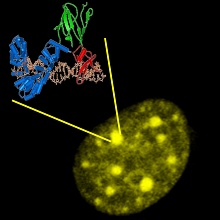New publication in "Nature Communications"
Epigenetic information consists of chemical alterations of the DNA and the DNA-packaging proteins at defined positions. This information is necessary for the development of multicellular organisms and is significantly involved in the development of diseases. The research group of Prof. Jeltsch at the Institute of Biochemistry and Technical Biochemistry of University Stuttgart has now developed a method allowing for the first time to read epigenetic information in living cells. The method is based on the specific binding of anchoring molecules in the genome combined with the recognition of epigenetic signals by reading proteins. When these signals are present at a particular site, both elements bind close together and a fluorescence protein is activated, which can be detected in fluorescence microscopes. This is documented in the figure, showing the nucleus of a human cell in which the components of the detection system are expressed. This novel method opens up many possibilities for the reprogramming of epigenetic information during the development of organisms and also in the development of diseases.
| Contact | Prof. Dr. Albert Jeltsch |
|---|


